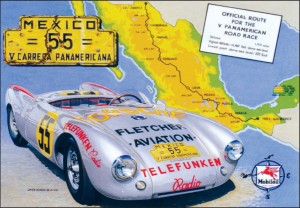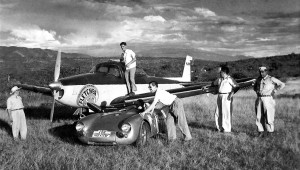By Daryl Murphy

“19 Hours,” by Dave Kurz, celebrates the historic Mexican road race, the Carrera Panamericana. The car featured is only the fourth Porsche Spyder chassis made by the manufacturer.
Carrera Panamericana was the wildest, woolliest auto race ever staged on an international scale. From 1950 to 1954, an estimated 10 million people witnessed the race along its nearly 2,000-mile course. While some of the cars could reach 180 mph on the desert straights, they would also have to switch to low gear to get through some of the fogbound mountain passes.
The race was run in eight legs over five days, each leg varying from 75 to 329 mile. That meant that support crews raced from point to point in order to keep up with their race cars. Carrera had its own air force, a caravan of everything from Tri-Pacers to DC-3s, carrying mechanics, parts, newsmen, observers and VIPs from each day’s starting point to the finish line.
One of the pilots who flew the race was the late Don Downie, a veteran Flying magazine contributor.
“I had the opportunity to fly it for two years, 1953 and 1954,” Downie related several years ago. “I flew support for the Porsche team in the Fletcher Aviation “jet-cooled” Navion. At that time, Fletcher had a contract to build Porsche engines in the U.S., and it was logical to help their competition racing team.”
The race started in Tuxtla Gutierrez, in the Mexican state of Chiapas, which borders Guatemala. It ended in Ciudad Juarez, across the Rio Grande from El Paso, Texas. In the first year of competition, only two of the 10 cars entered survived to the finish, both driven by private entrants. In 1954, of the seven cars entered, six finished and the factory cars placed 1-2.
|
After the start of each leg, Downie and other pilots would transport their support crews to the finish line, so they would be in place to prepare the cars for the next leg.
“I flew a variety of German mechanics,” Downie said. “The language problem was rough since I didn’t speak German, and they spoke no English. We wound our way across Mexico with sign language and an occasional ‘Nein’ and ‘Kaput!'” Downie explained that the canyons on the early stages of the course below Mexico City are narrow, and the mountains spectacular. “We had armbands with the word ‘invitado’ (invited), which made it possible to do just about anything and get away with it,” he said. “Nobody cared how low you flew or if you buzzed the crowd. It was all part of the Carrera!” Downie took photographs while flying over the race course and also while on the ground before the starts and between legs. |
“In the flat country, I would go down to shoot pictures of the cars, flying with rubber and trim tab,” he said. “On the straight stretches, a few of the faster cars passed me.”

Karl Kling’s Porsche 550 poses with the “jet-cooled” Navion in 1953 at Tuxtla Gutierrez Airport. Don Downie flew the Navion for Fletcher Aviation.
One of these low-level aerial photos graces the title page of my 1993 book, “Carrera Panamericana: History of the Mexican Road Race,” published by Motorbooks International.
“It’s all the more spectacular when you learn it was shot with a 4×5 Speed Graphic camera, out the passenger’s side window of an airplane that’s flying perhaps 100 feet above the ground at 120 miles per hour,” Downie said.
He remembered that it was a great era while it lasted.
“The two years I flew it were great sport, high adventure and the opportunity to work with some of the finest, wildest lead foots in the business,” he said. “It must have been during this time that the word ‘macho’ was born!”











